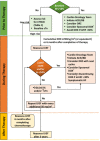Surviving Cancer without a Broken Heart
- PMID: 31002639
- PMCID: PMC6474762
- DOI: 10.5041/RMMJ.10366
Surviving Cancer without a Broken Heart
Abstract
Chemotherapy-associated myocardial toxicity is increasingly recognized with the expanding armamentarium of novel chemotherapeutic agents. The onset of cardiotoxicity during cancer therapy represents a major concern and often involves clinical uncertainties and complex therapeutic decisions, reflecting a compromise between potential benefits and harm. Furthermore, the improved cancer survival has led to cardiovascular complications becoming clinically relevant, potentially contributing to premature morbidity and mortality among cancer survivors. Specific higher-risk populations of cancer patients can benefit from prevention and screening measures during the course of cancer therapies. The pathobiology of chemotherapy-induced myocardial dysfunction is complex, and the individual patient risk for heart failure entails a multifactorial interaction between the selected chemotherapeutic regimen, traditional cardiovascular risk factors, and individual susceptibility. Treatment with several specific chemotherapeutic agents, including anthracyclines, proteasome inhibitors, epidermal growth factor receptor inhibitors, vascular endothelial growth factor inhibitors, and immune checkpoint inhibitors imparts increased risk for cardiotoxicity that results from specific therapy-related mechanisms. We review the pathophysiology, risk factors, and imaging considerations as well as patient surveillance, prevention, and treatment approaches to mitigate cardiotoxicity prior, during, and after chemotherapy. The complexity of decision-making in these patients requires viable discussion and partnership between cardiologists and oncologists aiming together to eradicate cancer while preventing cardiotoxic sequelae.
Conflict of interest statement
Figures



References
-
- Zamorano JL, Lancellotti P, Rodriguez Munoz D, et al. 2016 ESC Position Paper on cancer treatments and cardiovascular toxicity developed under the auspices of the ESC Committee for Practice Guidelines: The Task Force for cancer treatments and cardiovascular toxicity of the European Society of Cardiology (ESC) Eur J Heart Fail. 2017;19:9–42. doi: 10.1002/ejhf.654. - DOI - PubMed
Publication types
LinkOut - more resources
Full Text Sources
Research Materials

